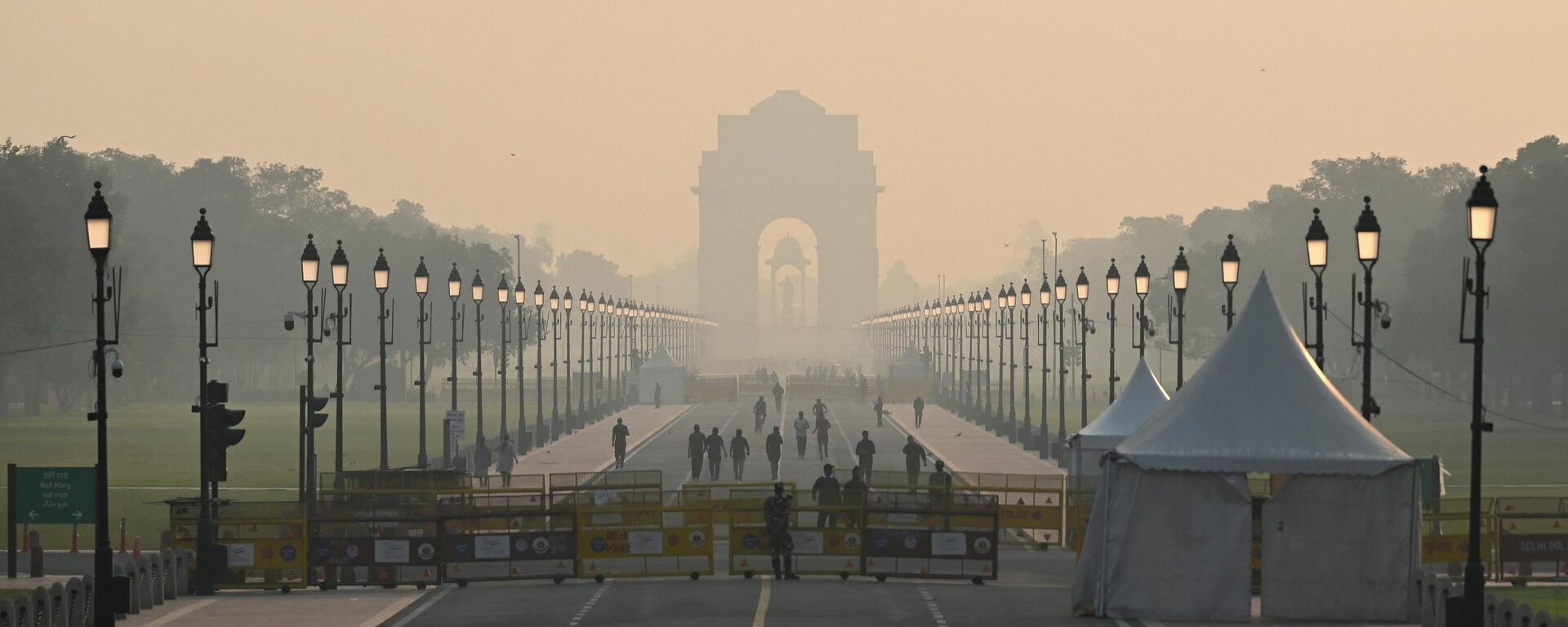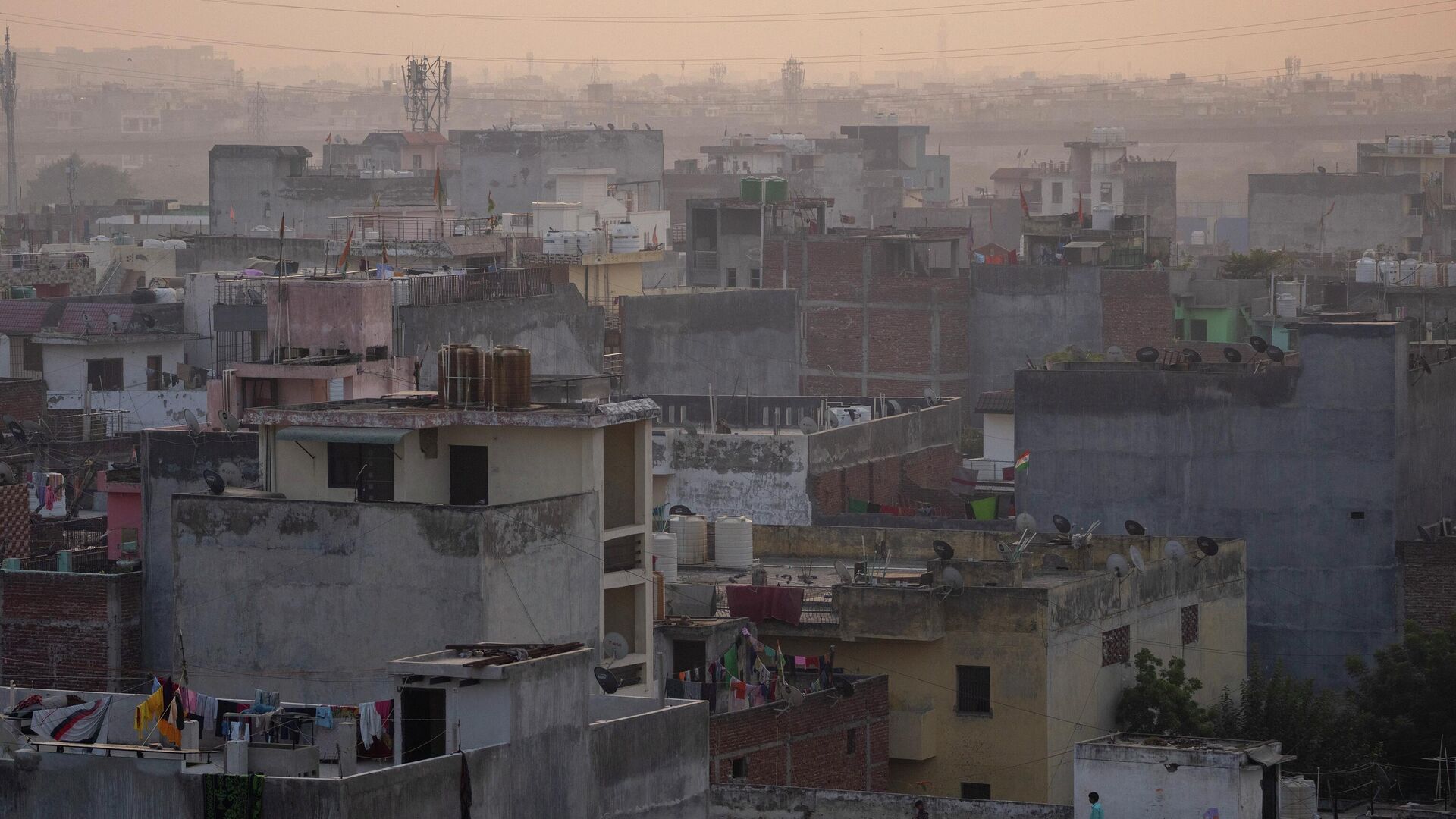https://sputnikglobe.com/20221101/delhi-braces-for-sore-throat--allergy-flare-ups-as-hazardous-smog-blankets-city-1102912453.html
Delhi Braces for Sore Throat & Allergy Flare-ups as Hazardous Smog Blankets City
Delhi Braces for Sore Throat & Allergy Flare-ups as Hazardous Smog Blankets City
Sputnik International
As the air quality index in Delhi-NCR plunged to somewhere between the poor and severe categories in late October, citizens are now complaining about... 01.11.2022, Sputnik International
2022-11-01T13:39+0000
2022-11-01T13:39+0000
2022-11-01T13:39+0000
india
delhi
new delhi
air pollution
air pollution
air quality
https://cdn1.img.sputnikglobe.com/img/07e6/0b/01/1102921103_0:160:3073:1888_1920x0_80_0_0_60ec3bdd18e56ce2737743a0c1d8aeee.jpg
Amid falling temperatures and a rising number of stubble-burning incidents, Delhiites woke up on Tuesday to thick toxic smog blanketing the city, with the visibility level dropping to less than 400 metrers.According to data provided by the Central Pollution Control Board, an air quality index (AQI) of more than 400 was recorded in several parts of Delhi and the National Capital Region (neighboring cities) on Tuesday. As an AQI level above 400 affects even healthy people, it's needless to say how those already suffering from various illnesses are coping with increased air pollution.Singh, who is also a member of an old age group in his residential area, said he used to meet his friends in the park during morning walks and yoga on a daily basis, but now, he has to suspend the regular meet-ups.“I think we will start our meeting in February or late January only. We all know that pollution will not improve in the coming days. It will only worsen,” he added.“I can’t take my child out these days. I can feel that the pollution level is increasing. We have switched on the air purifier for the past 15 days. But if I have options to move to another city, why not?” Bano, who works as a software developer, said.“I’m worried about my child. This is not safe for her,” she added. Bano also said that since her company functions remotely, it does not matter where she works from.“There’s an increased number of patients with exaggerated symptoms like shortness of breath, decreased SPO2 (Oxygen Saturation) levels, heart attacks requiring oxygen support and Intensive Care Unit (ICU) care on those who are already having asthma, allergies and other cardiopulmonary issues,” Dr. Shelie Kaushik, casualty medical officer at Kailash Deepak Hospital, Delhi, told Sputnik.Even those who have been generally healthy are now facing symptoms like coughing, sneezing, irritation in the eyes, and itchy ears, Kaushik noted.Graded Response Action Plan (GRAP)Every winter, the India capital is blanketed with smog, constituted mainly of air trap construction dust, vehicle emissions, and smoke caused by burning crop residue in neighboring states, namely Haryana, Punjab, and Uttar Pradesh.According to the Ministry of Earth Science, stubble-burning smoke this year has contributed up to 26 percent of the PM 2.5 in the city’s air, the highest in the past two years around this time.Delhi Environment Minister Gopal Rai announced on Monday that 586 teams had been formed to monitor hospitals, railways, and airports for violations, since construction at these sites has been banned until further notice. Other public sectors can continue with construction activities, but with dust-control measures in place.The city government has also deployed nearly 233 anti-smog guns and 521 machines to sprinkle water across the city to settle dust.“Pollutants are getting trapped due to atmospheric pressure,” Jenamani added.
https://sputnikglobe.com/20221025/dont-blame-diwali-blame-kejriwal-bjp-slams-delhi-chief-minister-over-poor-air-quality-1102607010.html
delhi
new delhi
Sputnik International
feedback@sputniknews.com
+74956456601
MIA „Rosiya Segodnya“
2022
Deexa Khanduri
https://cdn1.img.sputnikglobe.com/img/07e4/0c/1e/1081607388_0:0:961:960_100x100_80_0_0_e9e931b8c1e18fb41f3074e2145d7a3a.jpg
Deexa Khanduri
https://cdn1.img.sputnikglobe.com/img/07e4/0c/1e/1081607388_0:0:961:960_100x100_80_0_0_e9e931b8c1e18fb41f3074e2145d7a3a.jpg
News
en_EN
Sputnik International
feedback@sputniknews.com
+74956456601
MIA „Rosiya Segodnya“
Sputnik International
feedback@sputniknews.com
+74956456601
MIA „Rosiya Segodnya“
Deexa Khanduri
https://cdn1.img.sputnikglobe.com/img/07e4/0c/1e/1081607388_0:0:961:960_100x100_80_0_0_e9e931b8c1e18fb41f3074e2145d7a3a.jpg
india, delhi, new delhi, air pollution, air pollution, air quality
india, delhi, new delhi, air pollution, air pollution, air quality
Delhi Braces for Sore Throat & Allergy Flare-ups as Hazardous Smog Blankets City
Deexa Khanduri
Sputnik correspondent
As the air quality index in Delhi-NCR plunged to somewhere between the poor and severe categories in late October, citizens are now complaining about difficulty breathing, sore throats, and eyesight issues.
Amid falling temperatures and a rising number of stubble-burning incidents, Delhiites woke up on Tuesday to thick toxic smog blanketing the city, with the visibility level dropping to less than 400 metrers.
According to data provided by the Central Pollution Control Board, an air quality index (AQI) of more than 400 was recorded in several parts of Delhi and the National Capital Region (neighboring cities) on Tuesday.
As an AQI level above 400
affects even healthy people, it's needless to say how those already suffering from various illnesses are coping with increased air pollution.
“I’ve been [suffering from] sore throat and cold for a week already. Almost everyone at my house has a health problem due to this hazardous pollution,” Dhananjay Singh, 66, a resident of Vaishali, Ghaziabad, told Sputnik when approached at Max Hospital on Tuesday.
Singh, who is also a member of an old age group in his residential area, said he used to meet his friends in the park during morning walks and yoga on a daily basis, but now, he has to suspend the regular meet-ups.
“I think we will start our meeting in February or late January only. We all know that pollution will not improve in the coming days. It will only worsen,” he added.
Meanwhile, Kulsum Bano, the mother of an 18-month-old baby from Delhi's Jamia Nagar area, told Sputnik that she would be shifting to her home state Jharkhand for two-three months due to the pollution.
“I can’t take my child out these days. I can feel that the pollution level is increasing. We have switched on the air purifier for the past 15 days. But if I have options to move to another city, why not?” Bano, who works as a software developer, said.

25 October 2022, 10:51 GMT
“I’m worried about my child. This is not safe for her,” she added.
Bano also said that since her company functions remotely, it does not matter where she works from.
Doctors also confirmed to Sputnik that respiratory illness and chronic obstructive pulmonary disease (COPD) emergencies have been reported over the past week.
“There’s an increased number of patients with exaggerated symptoms like shortness of breath, decreased SPO2 (Oxygen Saturation) levels, heart attacks requiring oxygen support and Intensive Care Unit (ICU) care on those who are already having asthma, allergies and other cardiopulmonary issues,” Dr. Shelie Kaushik, casualty medical officer at Kailash Deepak Hospital, Delhi, told Sputnik.
Even those who have been generally healthy are now facing symptoms like coughing, sneezing, irritation in the eyes, and itchy ears, Kaushik noted.
Graded Response Action Plan (GRAP)
Every winter, the India capital is blanketed with smog, constituted mainly of air trap construction dust, vehicle emissions, and smoke caused by burning crop residue in neighboring states, namely Haryana, Punjab, and Uttar Pradesh.
According to the Ministry of Earth Science, stubble-burning smoke this year has contributed up to 26 percent of the PM 2.5 in the city’s air, the highest in the past two years around this time.
Delhi Environment Minister Gopal Rai announced on Monday that 586 teams had been formed to monitor hospitals, railways, and airports for violations, since construction at these sites has been banned until further notice. Other public sectors can continue with construction activities, but with dust-control measures in place.
The city government has also deployed nearly 233 anti-smog guns and 521 machines to sprinkle water across the city to settle dust.
Meanwhile, India Meteorological Department (IMD) scientist R. K. Jenamani told Sputnik that as the crop residue burning continues, weather conditions such as calm winds, low temperatures, and a low mixing height are now favorable for the accumulation of pollutants and staying in the air for a more extended period.
“Pollutants are getting trapped due to atmospheric pressure,” Jenamani added.





